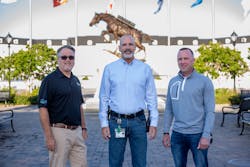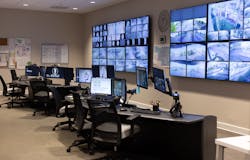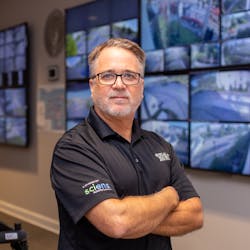This article is part of the annual Security Vanguard Awards, presented by SecurityInfoWatch.com, Security Business magazine and Security Technology Executive (STE) magazine. Learn more about the Vanguard and its many winners over the years at www.securityinfowatch.com/vanguard.
The premise for any successful security systems buildout is that it is flexible and designed with future expansion in mind. While these were certainly factors that were prime drivers for operators of the World Equestrian Center (WEC) in Ocala, Fla., even the on-site security management team and the systems integration group that oversaw this expansive project could not have anticipated the whirlwind of complexity the job would entail.
Because of the strong collaboration between user and integrator within such a high-stress and diverse project as the WEC, it has been named the 2022 Security Vanguard Award Project of the Year from SecurityInfoWatch, Security Business magazine and Security Technology Executive (STE) magazine.
“Because of the sheer size of the project and the number of cameras and access control points that are installed here, itThe WEC is a one-of-a-kind equestrian center designed for world-class breeders and competitors. It is a veritable maze of venues that features not only areas reserved for the world’s top equine competitors – showcasing climate-controlled stables for 2,000-plus horses, five arenas and a large animal veterinary clinic – the resort-like property also includes an RV park, an expo center and a first-class hotel on nearly 380 acres of sprawling horse country, with an additional 300 acres set aside for future expansion.
From its inception, the security management staff and the developer agreed that a facility destined to house the world’s most majestic and valuable livestock also needed a security system with a blue-ribbon pedigree.
Collaboration was Key
The job of securing this sprawling first-in-show property nestled among the gently rolling hills of central Florida fell to Security Director Kevin O’Rourke, who in 2017 hand-selected integrator SmartWatch Security & Sound – which was actually acquired by Sciens Building Solutions mid-project – for the job.The WEC project has morphed beyond the original blueprints as new venues on the property have come online and others have been retrofitted. This quirk has required a constant balancing act between the end-user and the systems integrator, as the footprint has grown to more than 900 cameras and 145 doors of integrated access control.
O’Rourke, who has a law enforcement background, realized early on that SmartWatch brought invaluable experience to the project from years of close working relationships with Orlando’s Universal Studios and other large outdoor entertainment venues.
“At the end of the day, you’ve literally got people whose livelihoods depend on us,” O’Rourke explains. “A good portion of them have horses that, quite frankly, could be more expensive than [most] people’s houses. When you look at it strictly from a liability standpoint, being able to make accurate determinations – not just a guess as to what [event] may have transpired – was a crucial element of putting this security [framework] together.”
The dilemma O’Rourke faced was that although everything management wanted to do at WEC from a security perspective was realistic, the project continued to expand over myriad months forcing numerous change orders.
“This particular layout is not where we initially started – it was not nearly at this scale,” O’Rourke says. “Once we were into it, we had to continue to follow that path for the entire campus. Once we recognized that, we looked at the layouts of the barns, for example, and we came up with a game plan for minimizing the actual number of cameras and hardware required – but at the same time covering an area that would have required four different cameras.”
Video Surveillance is the Foundation
Video surveillance and storage has played a significant role in the WEC security footprint, especially around the barns, horse stalls, staging areas around the equine arenas, and parking areas. Remington emphasizes that because of liability issues to horse, rider and owners, the video system had to be ubiquitous.
“The number one concern was injury to the livestock,” Remington explains. “Usually, we think of slip-and-falls in a mall where someone falls and bangs their head, and they file a big lawsuit. If somebody pulls a million-dollar horse out of a barn and it stumbles because the floor is wet, and the horse can no longer perform or get stud fees – the implications areLooking to alleviate liability issues around the barns while also creating a streamlined security operation for staff in the 24/7 Security Operations Center (SOC) mandated that strategic camera placement, adequate storage and an intuitive video management system were essential. Remington’s integration team installed more than 30 IP video cameras from Axis Communications in each of the 26 barns, with each being placed at a key intersection point for full coverage using minimal devices.
“From personal experience, I know you have to see as much as possible, so I focused on coverage,” O’Rourke explains. “That’s the mindset that we tried to follow, understanding that efficiency [was also important]. We were able to do that with technology [such as] 360-degree fisheye cameras that can [cover an area] where you would [ordinarily] need three fixed view cameras.”
O’Rourke says the sprawling WEC campus currently uses around 940 cameras with approximately 1,650 to 1,680 corresponding video streams flowing into the SOC. This required a vast amount of connectivity and storage, which Remington says is exclusively handled by an array of data servers from Seneca.
“There are 19 servers overall, at 124 terabytes [of storage] each,” Remington says, adding that they are arrayed both in a main server farm and at the edge. “The network is so robust, you can literally hang a server anywhere and it will perform, so we didn’t have to worry about bandwidth.”
“We try to keep our archive at a usable number, which has worked pretty well, because economically speaking, you can’t store [video] forever,” O’Rourke adds. “Typically, for an event or an issue that we are reviewing, we are usually aware of it within hours, days or at most, a week – and we have the capability to go back and do a productive review.”
Of course, while many of the cameras are covering the stables and other equine areas, the RV park, show venues and hotel also require a great deal of video technology. Remington admits that he and O’Rourke decided early in the project that it would be impossible to economically issue individual event badges or task a manned guard force with crowd control on such a massive scale.
“It is definitely what we would consider a hospitality project, because there is a resort on property, but it is also very unique in that it’s an entertainment complex with the show arenas,” Remington says. “The back-of-house stables were the original concern for the owners of the property, but it turns out that theft, operations – all those typical worries that anybody in a hotel or resort or theme park would have – also became items of interest for the security staff.”Remington adds that the sheer size of the property means often covering multiple events at once. “It is so big that you could literally have 30 different events going on throughout the weekend,” he says. “At one arena, you’ve got a car show; in another arena, you have a craft fair. It would be too problematic to try to control access in and out of the property, so the decision was made to just blanket the area with [surveillance] coverage.”
Facilitating an ability to integrate open technology with an eye towards economy of scale led WEC to choose solutions from companies like Axis, Seneca and Milestone Systems (VMS), as well as Gallagher for the access control systems and Von Duprin for the electronic door hardware.
Inside the Security Operations Center
Within the 2,000-square-foot SOC, operators at custom consoles provided by Middle Atlantic can monitor two Planar video walls as well as desktop monitors for up-close viewing.The SOC is staffed 24/7 and also serves as the WEC security dispatch center as well the video monitoring hub. This approach allows O’Rourke and his security team to have the capability – through a two-way radio system – to reach out to any officer at any moment, anywhere on the property. O’Rourke adds that the SOC had to be large enough so his team could not only monitor ongoing events, which he admits is almost impossible to do in real-time given the scale of the video surveillance system, but also accommodate security staff that were reviewing older video and those performing forensics.
“We view all the main hot spots or intersecting areas, and that basically takes up three workstations and one video wall,” O’Rourke says. “We then have a second video wall with three workstations assigned to that video wall, so when we have a specific event – a home and garden show going on in expo one, for example – it allows us to simultaneously concentrate on that. We’re not giving up our normal operations and strictly focusing on one event because we have [the capability to monitor] multiple things going on the property at once.”
Lessons Learned
The key to success on a project of this scale, according to both O’Rourke and Remington, was a top-down understanding of what would be involved, and then making the commitment to achieving it on the WEC campus.
“[WEC management] operates a number of large corporations, so at the end of the day, they understand security and the need for it from a business standpoint,” O’Rourke says. “There was going to be some investment required, but then the project kept expanding.”
In fact, Remington chuckles when thinking back to the number of times “the project kept expanding” – after all, what started at a 30-building project morphed into 330 acres of facilities. Still, he stresses that having a solid working relationship with a customer and serving as a trusted advisor is the key to success.“Know your customer, and listen to what they have to say,” Remington says. “That’s what I have learned most from dealing with Kevin, because he is a smart guy, and he always has a lot of great points to offer. But in the end, he always relied on our knowledge and expertise to make the decision on which products to go with and whether they were appropriate or not.”
Steve Lasky is Editorial Director of the SecurityInfoWatch Media Group, which includes Security Business, SecurityInfoWatch.com, Security Technology Executive (STE) magazine and Locksmith Ledger International. Paul Rothman is Editor-in-Chief of Security Business.
M&A Catastrophe Avoided
How SmartWatch Security & Sound kept an award-winning project on track despite being acquired at the halfway mark
Putting together an ever-growing but award-winning security project is never easy for an integration firm – now try doing it in the midst of being acquired by another integrator. Such was the case for Brian Remington and SmartWatch Security & Sound, which was acquired by Sciens Building Solutions in 2019 – at roughly the halfway mark of the World Equestrian Center (WEC) project.
“It probably went as well as any acquisition of a small company by a large organization – I have never been a part of it before, so it was a new experience for me,” Remington says. “I would say that the Sciens takeover really had no impact on the overall growth, or modifications to the WEC project. They were very hands-off and understanding of our relationships with our existing customers, and they continue to be so. Obviously [Sciens] has its own policies and procedures, and we are working those into our system. That has affected some of our business, but not in a negative way – it just changes how we do things.”
Still, one of the first orders of business in this situation is communication. Remington says he had sit-down meetings with all his major customers to communicate the transition.
“We had principals from Sciens come out and attend large meetings wherever it was appropriate,” he explains. “But to be honest, if you are the general contractor or the electrical contractor [on a project], they just want to know that I’m going to pick up the phone when they call, and that my project manager is going to be the same guy they’ve been dealing with for years, and when we get on-site, the parts get delivered when they are supposed to.”
Project Overview: World Equestrian Center
Project submitted by: Sciens Building Solutions
End-User: World Equestrian Center (WEC), Ocala, Fla.
Integrator: SmartWatch Security & Sound (a Division of Sciens Building Solutions)
Access Control Management System: Gallagher
Electrified Door Hardware: Von Duprin (ASSA ABLOY)
IP Cameras: Axis Communications
Video Management Software (VMS): Milestone Systems
Data Servers: Seneca Data
Video Walls: Planar
SOC Consoles: Middle Atlantic Products
About the Author
Steve Lasky
Editorial Director, Editor-in-Chief/Security Technology Executive
Steve Lasky is Editorial Director of the Endeavor Business Media Security Group, which includes SecurityInfoWatch.com, as well as Security Business, Security Technology Executive, and Locksmith Ledger magazines. He is also the host of the SecurityDNA podcast series. Reach him at [email protected].
Paul Rothman
Editor-in-Chief/Security Business
Paul Rothman is Editor-in-Chief of Security Business magazine. Email him your comments and questions at [email protected]. Access the current issue, full archives and apply for a free subscription at www.securitybusinessmag.com.



![The World Equestrian Center often showcases “horses that, quite frankly, could be more expensive than [most] people’s houses,' O'Rourke explains. The World Equestrian Center often showcases “horses that, quite frankly, could be more expensive than [most] people’s houses,' O'Rourke explains.](https://img.securityinfowatch.com/files/base/cygnus/siw/image/2022/10/WEC_Main_Ring_2.63583e1c92b4b.png?auto=format,compress&fit=max&q=45?w=250&width=250)
![“[WEC management] operates a number of large corporations, so at the end of the day, they understand security and the need for it from a business standpoint.” - Kevin O’Rourke, WEC Director of Security “[WEC management] operates a number of large corporations, so at the end of the day, they understand security and the need for it from a business standpoint.” - Kevin O’Rourke, WEC Director of Security](https://img.securityinfowatch.com/files/base/cygnus/siw/image/2022/10/1x1/Kevin_O_Rourke.63583e263e1a0.png?auto=format,compress&fit=max&q=45?w=250&width=250)



